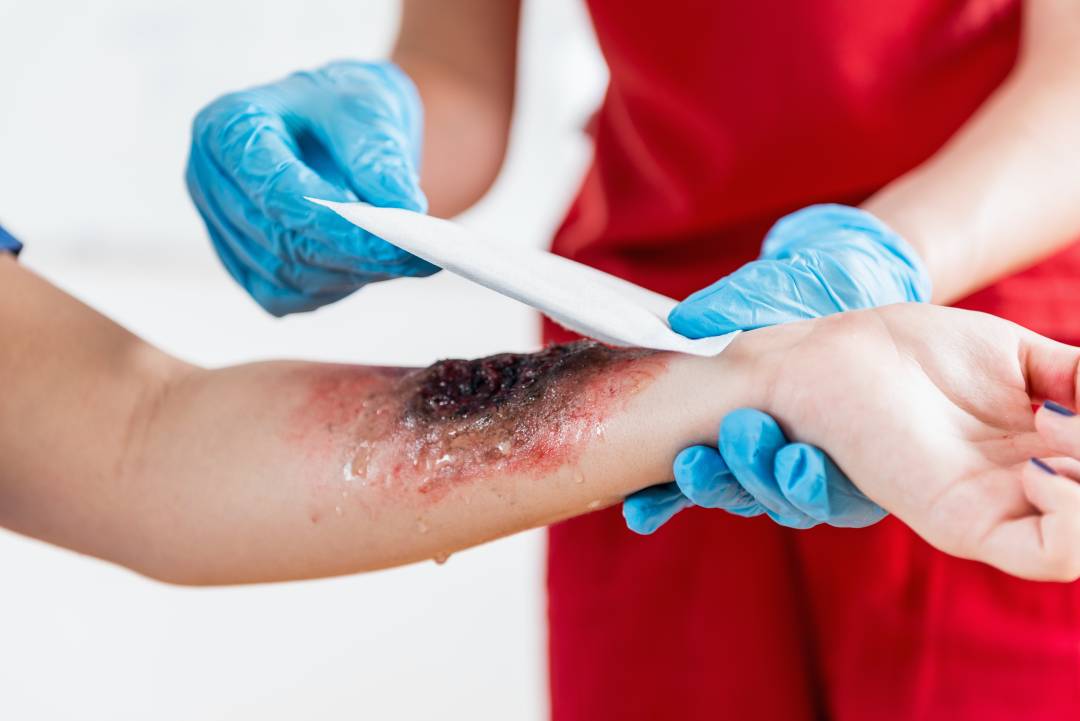The basic elements involved in assessing the severity of a burn are the depth and surface of the affected skin.
EPIDERMAL (1st degree)
- The epidermis is minimally damaged.
- The skin is red.
- She is still sensitive.
- The skin is dry.
- No bubbles.
SURFACE DERMAL (2a degree)
- The epidermis and dermis are damaged.
- Blisters filled with liquid, thin walls.
- The skin is pink.
- The skin is moist.
- The burn fades to the touch.
DEEP DERMAL (2b degree)
- It can penetrate the subcutaneous tissue.
- Bubbles have thicker walls, sometimes punctured.
- The color of the skin is white or red.
- Severe pain when pressing on the burned area.
SUBDERMAL (3rd degree)
- Epidermis and subcutaneous tissue are destroyed.
- The skin is white, burnt.
- The skin is dry.
- It is not sensitive to touch.
The assessment of the depth of burns within the first 24 hours after the injury is only an orientation, because the final assessment of the depth of burns changes due to the interaction of different body defense mechanisms and the action of harmful substances. It depends on the state of the circulatory system, the formation of edema, thrombosis of blood vessels.
The extent of the burn is expressed as a percentage of burned skin in relation to the total body surface area (TBSA – total body surface area). The “Rule of Nines” is used to quickly determine the size of a burn. The body is divided into 11 regions, which in adults have approximately equal areas.
These are:
- Head and neck: 9%
- Front trunk: 2 x 9%
- Rear hull: 2 x 9%
- Front legs: 9% (2 x 9%)
- Hind legs: 9% (2 x 9%)
- Hands: 9% (2 x 9%)
All of this adds up to 11 x 9% = 99%, with the remaining 1% relating to the perianal area.
According to the American Burn Association guidelines, there are three degrees of burn severity:
Severe burns:
- 20% of the burn area in young and older adults
- 25% of the surface in people aged 10-50
- 10% of deep burns regardless of age Moderately severe burns Superficial burns 15-25% in people aged 10-50 Superficial burns 10-20% in people under 10 and over 50 Deep burns 2-10% at any age Less burns Superficial burns less than 15% in people aged 10-50 Superficial burns less than 10% in os
Burns in neurogenic areas (face, hands, perineum) Burns above major joints Inhalation of smoke Burns associated with fractures and other injuries Burns in patients with existing chronic degenerative diseases
Severe burns due to large amounts of toxic substances released at the site of injury that enter the circulation lead to systemic changes. These changes take place in stages and are called burn disease. For conditions outside the hospital, the development of burn shock and prevention of acute renal failure are important. Severe burn injuries cause weakening of the cardiovascular system.
Increased capillary permeability occurs, and shortly after severe burns, hypovolemic shock may develop. Hypovolemia causes hypoperfusion of many organs. In order to ensure adequate blood pressure to the body, vasoconstriction occurs in many organs. The first organ that tries to compensate for the reduced blood flow is the skin, followed by the muscles, digestive tract and kidneys (centralization of circulation). All this is done to ensure sufficient perfusion to the heart and brain. In the case of severe hypovolemia, the blood pressure is too low.
If we do not replace the volume of fluid that is missing in the body, it can lead to cardiac arrest – death! Burn shock can be treated with large amounts of intravenous fluids, but this can be controversial! (Ischemic tissues can be damaged during reperfusion – reperfusion injury). With the return of circulation, inflammatory mediators and leukocytes begin to be released in the ischemic tissue. This activation of the inflammatory response can cause injury to distant organs, such as the lungs (SIRS – systemic inflammatory response).
Moderately serious burns
- Superficial burns 15-25% in people aged 10-50
- Superficial burns 10-20% in people younger than 10 and older than 50 years
Deep burns
- 2-10% at any age
Minor burns
- Superficial burns less than 15% in people aged 10-50 years
- Superficial burns less than 10% in os



0 Comments